How to Find Federal Grants A Practical Guide
Discover how to find federal grants with this practical guide. Learn to master Grants.gov, decode announcements, and secure funding for your organization.
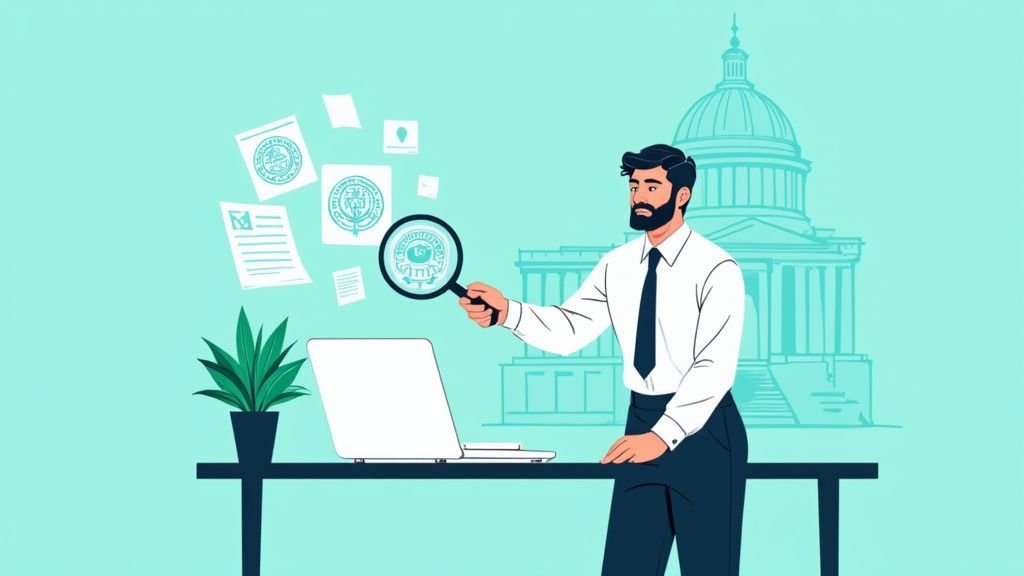
The path to securing a federal grant almost always starts at the same digital doorstep: Grants.gov. This is the official U.S. government platform, and it’s where all 26 federal grant-making agencies post their funding opportunities. Think of it as the central nervous system for over 1,000 grant programs.
Your Starting Point for Federal Grant Discovery
Trying to find the right federal grant can feel overwhelming at first. It’s not just about knowing where to look, but how to look. Before you even type a single keyword into a search bar, taking a moment to understand the landscape will save you a world of frustration later.
The sheer amount of money on the table is staggering. Just to give you an idea, the Department of Education alone made a record $114.9 billion in grants and loans available for the 2023-24 academic year. In the previous cycle, more than 17 million students and families filled out a Free Application for Federal Student Aid (FAFSA). These federal financial aid statistics highlight just how vast and competitive this space is, which is why a solid strategy is non-negotiable.
Navigating the Central Hub: Grants.gov
Your first and most important tool is Grants.gov, the government's official portal for all federal grant opportunities. While other tools and databases exist, this is the primary source. Everything else is just a different window into this same information.
When you land on the homepage, you'll see a straightforward search interface. This is your launchpad.
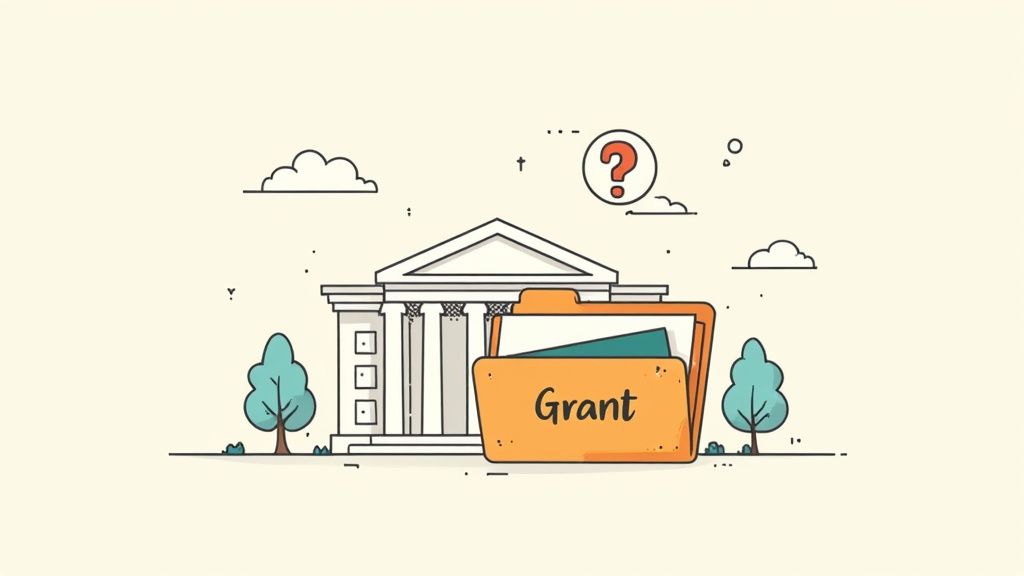
From here, you can start a broad search with a keyword or narrow things down if you already know the specific opportunity number or the agency you're interested in. Every single active funding announcement—from the Department of Agriculture to the National Endowment for the Arts—is accessible from this page.
Understanding Key Grant Terminology
Before you dive in, let’s get a few key terms straight. Nailing this vocabulary will make every grant announcement you read much easier to understand.
Here’s a quick rundown of what you need to know as you begin your federal grant search.
Understanding these basic elements is the first step toward a more efficient and successful search.
One of the biggest mistakes I see people make is falling in love with a project description without first checking if it aligns with the funding agency's bigger picture.
An agency’s strategic plan is your cheat sheet. It lays out their long-term goals and priorities. If your project doesn't clearly connect to what they're trying to achieve, you're facing an uphill battle, no matter how brilliant your proposal is.
Mastering the Grants.gov Search Engine
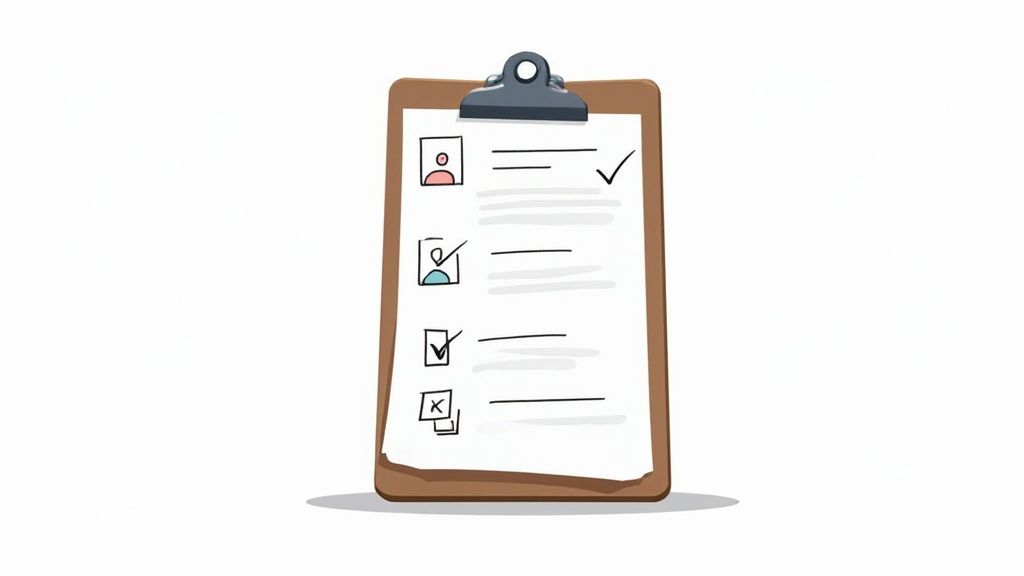
If you've ever typed a general phrase like "community health" into the Grants.gov search bar, you know the feeling. You’re immediately hit with a tidal wave of thousands of results, and most of them have nothing to do with what you actually need. This is where a lot of grant seekers just give up.
The secret isn’t just about having the right keywords. It’s about learning to master the platform's filters to cut through all that noise and get straight to the good stuff.
Think of the filters as your secret weapon. They let you stop shouting into the void and start having a targeted conversation with the database.
Go Beyond Basic Keyword Searches
To really get anywhere, you have to get strategic with the filters on the left-hand side of the search page. A few of them are absolute game-changers and should be the first ones you turn to.
Eligibility: This is non-negotiable and your most powerful filter. Are you a 501(c)(3) nonprofit, a small business, a local government? Check the right box here first. It’s the fastest way to stop wasting your time reading through grant guidelines for funding you were never qualified to receive in the first place.
Agency: If you know your work falls squarely under a specific department—like the Department of Health and Human Services (HHS) or the Environmental Protection Agency (EPA)—this filter is gold. You'll focus only on funders who are already aligned with your mission.
Category: This is a broader filter that groups opportunities by topic, like "Health," "Education," or "Arts." I find this is a great way to stumble upon grants you might have missed if you were just stuck on one or two specific keywords.
Let's put this into practice. Say you're running a local health clinic and want to start a new diabetes prevention program for seniors.
Just searching "diabetes program" will be a disaster. A much smarter approach is to layer your filters.
Start with your Keywords: "diabetes prevention" AND "senior health"
Next, lock in your Eligibility: "Nonprofits having a 501(c)(3) status with the IRS"
Then, narrow it down by Agency: "Department of Health and Human Services"
Finally, refine with the Category: "Health"
By doing this, you've just transformed an overwhelming list of 5,000 random results into a focused, manageable list of maybe 10-15 opportunities that are actually worth digging into. That’s a list you can actually work with.
The goal isn’t to find every possible grant; it’s to find the right grants. A focused search that yields five perfect fits is infinitely more valuable than a broad search that returns five hundred maybes.
Automate Your Grant Search
Here's a pro tip: finding grants isn't a one-and-done activity. Federal agencies post new opportunities every single day. If you're not checking constantly, you're going to miss out.
But who has time for that? The key is to make the system work for you.
Once you’ve built a search with filters that consistently gives you solid, relevant results, save it. Grants.gov lets you save your search queries and, more importantly, sign up for email notifications.
This means every time a new grant is posted that matches your exact criteria, an email lands right in your inbox. No more manual searching. This simple step turns Grants.gov from a passive, clunky database into an active lead-generation tool that’s always on the lookout for you. It's probably the single most efficient thing you can do to ensure a perfect-fit opportunity never slips through the cracks again.
Decoding Grant Opportunity Announcements
You’ve found it. A grant on Grants.gov that looks like a perfect match. That initial excitement is great, but now comes the real test: dissecting the Notice of Funding Opportunity (NOFO). These documents can be beasts—long, dense, and packed with bureaucratic jargon. Learning how to read them efficiently is probably one of the most critical skills you can develop in the grant world.
This isn't about reading the NOFO like a novel, from start to finish. It’s more like a strategic intelligence mission. Your job is to extract the key details that tell you whether to proceed or pass, and to do it in minutes, not hours.
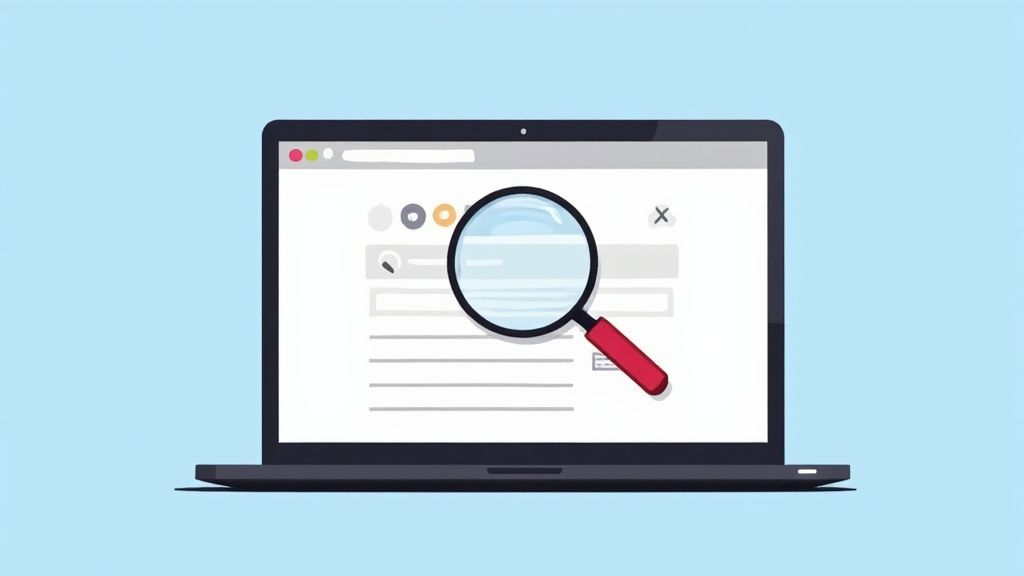
As this lifecycle chart from the Department of Health and Human Services shows, reviewing the announcement isn't just a suggestion; it's the bedrock of the entire application process. Getting this part right ensures you're not wasting precious time on a grant you can't win.
The Most Critical Sections to Find First
When that PDF opens, fight the urge to start at page one and read straight through. Instead, go on a scavenger hunt for the make-or-break information first. This quick scan will save you a world of hurt.
Here’s what I always look for immediately:
Project Summary: Think of this as the funder's elevator pitch. What problem are they trying to solve? Does their vision align with your mission? If it doesn’t resonate, it’s probably not a good fit.
Eligibility Information: This is the big one. It's the velvet rope. If your organization type (e.g., 501(c)(3), local government, university) isn't explicitly listed, you’re out. Don't try to bend the rules; it's a non-starter.
Award Information: How much money are we talking about? Look for the award ceiling (the max you can ask for) and floor (the minimum). Also, check how many awards they expect to make. This tells you how competitive the pool will be.
Key Dates: This is simple but crucial. Find the application deadline. Can your team realistically pull together a high-quality, thoughtful proposal by then? A rushed application is rarely a funded one.
I can't tell you how many times I've seen organizations get swept up in the excitement of a grant's purpose, only to realize dozens of hours later that they were never eligible in the first place. My advice? Always, always read the eligibility section first. No exceptions.
Spotting Red Flags and Mismatches
Beyond the basics, you have to learn to read between the lines. A grant can look perfect on the surface, but a hidden requirement can make it a nightmare. I once saw a small community garden nonprofit find a USDA grant for "urban agriculture." It sounded perfect! But buried on page 27 was a requirement for a $50,000 cash match and complex quarterly reporting that would have crushed their one-person staff.
Keep an eye out for these common deal-breakers:
Restrictive Criteria: The requirements are so narrow they box you in, preventing you from using your unique approach or serving your specific community.
Burdensome Reporting: The grant demands data tracking and reporting that your current systems and staff just can't handle. Be honest about your capacity.
Misaligned Scope: The funder’s definition of success or the required activities just don't jive with your organization's core mission or strategic goals. Chasing money that pulls you off-mission is a recipe for disaster.
Learning to decode these announcements is a foundational skill, but it's just the beginning. The intelligence you gather here is the raw material for your proposal. To see how to translate these requirements into a powerful story, take a look at our complete guide on https://www.fundsprout.ai/resources/writing-grant-proposals-for-nonprofits. It will show you how to connect the dots and build a narrative that gets funded.
Confirming Your Eligibility And Preparing To Apply
Here's a hard truth about federal grants: misreading the eligibility rules is the quickest way to waste dozens, if not hundreds, of hours on an application that's dead on arrival. Before you even dream of writing a proposal, your first job is to ruthlessly vet your organization's eligibility and then knock out a few critical administrative tasks.
The criteria for these grants can be shockingly specific. It’s rarely as simple as being a 501(c)(3) nonprofit. A funding opportunity might be limited to organizations within a single state, those serving a very particular demographic, or even those that have been operating for a minimum number of years.
Think of the eligibility section in the Notice of Funding Opportunity (NOFO) as a non-negotiable checklist. If you can't tick every single box, you have to walk away. It’s tough, but it’s better than writing a 50-page proposal that gets tossed out on a technicality.
The Critical Path To Application Readiness
So, you’ve confirmed you're a perfect fit? Great. Now the real administrative legwork begins. You’ll need to get registered in several federal systems before you can even think about submitting anything on Grants.gov. These aren't just simple sign-ups; they are multi-step verification processes that can easily take weeks. Putting this off is a recipe for disaster.
I can't tell you how many times I've seen this happen: a team finds the perfect grant two weeks before the deadline, only to realize the mandatory SAM.gov registration takes a month to clear. Do yourself a massive favor and start these registrations now, long before you have a specific grant in your sights.
Once your registrations are squared away, you can focus on building a winning proposal. This process has a natural flow to it.
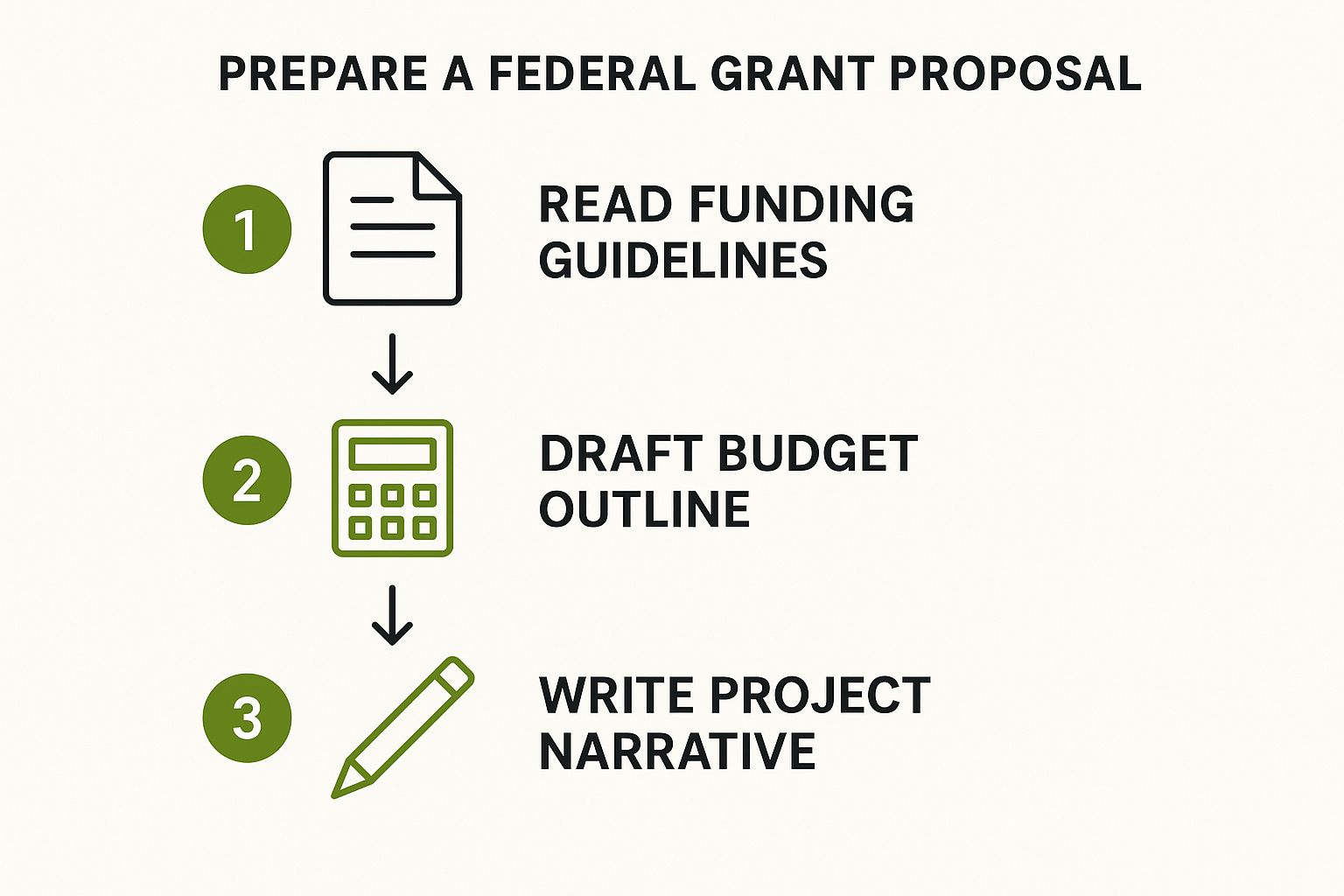
As you can see, everything builds on what came before, from really digging into the guidelines to crafting the story and budget for your project.
These upfront registrations are the absolute bedrock of your application. Getting them done early is a huge competitive advantage. If you're new to this world, our full grant writing for beginners guide can walk you through the proposal writing itself once you've handled these foundational steps.
Your Pre-Application Registration Checklist
Each of these systems has a specific role in the federal grant ecosystem, and you can't skip any of them. The timelines listed below are not exaggerations—they are based on real-world processing times.
Essential Pre-Application Registrations
Getting these done ahead of time makes all the difference.
Let me give you a real-world example. A small environmental nonprofit I know recently landed a $250,000 grant from the EPA. Their secret? They had renewed their SAM.gov registration three months before it expired. When the perfect grant dropped with a tight 30-day window, they were all-in on writing a fantastic proposal while other groups were stuck in a panic, just trying to get their registrations approved. That's the edge preparation gives you.
Expanding Your Search Beyond Grants.gov
While Grants.gov is the official starting line for federal funding, seasoned grant seekers know it shouldn't be the finish line. If you're only searching there, you’re likely missing out on critical context and opportunities that could give you a serious edge.
Treating Grants.gov as just one tool in a bigger toolbox is a pro move. It helps you zero in on federal grants that aren't just a possible fit, but a perfect one.
Go Straight to the Source
One of the most effective strategies I’ve seen is simply going directly to the websites of individual federal agencies. If your nonprofit works in environmental conservation, for example, you should be making a habit of checking the Environmental Protection Agency's (EPA) own grants page.
You'll quickly find that these agency-specific sites offer a goldmine of information you just won't see on the main portal.
Crucial Context: Agencies often post recordings of past informational webinars for applicants—an invaluable resource for understanding what they're really looking for.
Direct Support: You'll find detailed FAQs and, most importantly, the direct contact information for the program officers who can answer your specific questions.
A Glimpse into the Future: Many agencies announce their grant-making priorities and upcoming funding cycles long before a formal notice ever hits Grants.gov.
Using New Grant Discovery Tools
Beyond hitting the agency sites, a new generation of tools is making the whole discovery process much easier. Platforms that use AI can slash your research time by matching your organization’s profile to relevant opportunities from federal, state, and even foundation funders.
Think of it this way: Grants.gov is like a massive public library where you have to manually search the card catalog. An AI-powered platform is like having a personal librarian who already knows what you need and brings you a curated stack of perfect-fit books.
These tools can uncover grants you might have otherwise overlooked. A local food bank, for instance, probably wouldn't search for a Department of Transportation grant. But a smart platform could flag one that funds vehicles for the "last-mile delivery of essential goods"—a perfect, non-obvious match. Digging into how to find grants for nonprofits with these smarter methods can really set you apart.
Finally, never underestimate the power of your professional network. Subscribing to newsletters in your specific field and staying active in professional associations can give you early intel on where the funding is headed. This blend of direct agency research, smart technology, and good old-fashioned networking turns your grant search from a passive chore into a proactive, strategic hunt.
Frequently Asked Questions About Federal Grants
Diving into the world of federal funding can feel like learning a new language. You're bound to run into terms and processes that aren't immediately clear. Getting those questions answered is what separates a smooth application process from a frustrating one. Here are some of the most common questions I hear from grant seekers, answered with a bit of real-world perspective.
Discretionary Versus Mandatory Grants
So, what's the real difference between a discretionary grant and a mandatory grant?
Most of us are chasing discretionary grants. These are the competitive ones where a federal agency posts a notice, you submit your best proposal, and they review applications to fund the projects they believe have the most merit. It’s a competition, plain and simple.
On the other hand, mandatory grants aren't competitive. They're doled out based on a legal formula to entities that meet specific criteria. Think of a state government automatically receiving funds for a Medicaid program. If you qualify according to the law, you get the money—no competitive review required.
Finding Past Grant Winners
How can I figure out who won a particular grant in previous years? This is one of the smartest research moves you can make. It tells you what kind of projects a funder actually says "yes" to.
Your best bet is to head straight to USASpending.gov. It's a massive, searchable database of federal awards where you can dig in by agency, program, or keyword. I also recommend checking the agency’s own grant program page—they often post lists of past winners right there. This gives you a direct look at the projects they truly value.
Reviewing past winners isn't just about satisfying your curiosity—it's competitive intelligence. You’ll learn about the typical size of awards, see which organizations are consistently successful, and get a feel for the language that actually connects with reviewers.
Contacting A Program Officer
Is it a good idea to contact the program officer listed on the grant announcement? Yes, but you have to be smart about it.
A short, professional email is a great move if you have a thoughtful question about how your project fits or a technical requirement that's genuinely unclear in the notice. But never, ever ask a question that's already answered in the funding announcement. It signals you haven't done your homework.
A well-placed question shows you’re a serious applicant and can give you a bit of guidance that makes your proposal much stronger.
Realistic Timelines for the Process
From start to finish, how long does the federal grant process actually take? The short answer: a long time. This is a marathon, not a sprint.
Typically, the window to actually write and submit your application is open for 60 to 90 days.
Once you hit submit, the waiting game begins. The agency's review process can easily take another three to six months. If you're lucky enough to be selected, ironing out the award details and paperwork can add another month or two. Realistically, you should budget anywhere from six to nine months from the day you find the opportunity to the day the funds actually arrive. Sometimes, it can take even longer.
Finding the right grant is a huge step, but it’s just the beginning. At Fundsprout, we help you manage the entire grant lifecycle—from using our AI-powered engine to find opportunities that are a perfect fit, all the way through crafting a winning proposal and handling compliance. Stop chasing dead ends and start securing the funding your mission deserves. Explore how we can help at https://www.fundsprout.ai.
Try 14 days free
Get started with Fundsprout so you can focus on what really matters.
